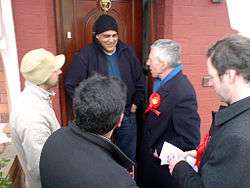Rosette (politics)
In politics, a rosette is a coloured fabric decoration worn by political candidates to identify them in many countries. The rosette, worn on the chest or suit jacket, will show the colours of the political party that the candidate represents.[1]

British politics
In British politics, rosettes (or sometimes flowers and ties) of a political party are often worn by candidates. As of 2016, the normal colours used are red for the Labour party (referenced in the party's official song), blue for the Conservative party, orange-yellow for the Liberal Democrat party, Green for the Green party and heather for the UK Independence Party. Of the nationalist parties, the SNP uses yellow, Plaid Cymru uses gold and green and the Democratic Unionist Party uses red, white and blue.
As of 2015, the only people allowed to wear a rosette at a polling station are candidates and their election agents.[2] "An X in a [coloured] rosette would/wouldn't get elected here" or variants of this phrase is often used to indicate a very safe seat, where X is a deeply undesirable candidate for the likely winning party or a saintly potential candidate for a losing party.[3][4] During the 1980s and 90s, first Neil Kinnock and then the New Labour movement under Blair encouraged the use of red roses as a symbol of the Labour party, and the party used the rose as a logo.[5]
In the U.K., despite its relatively long-lasting set of major parties, colours worn by parties have not always been constant.[6] In some areas, non-standard colours were worn up to around the 1970s as a local tradition. This may have been for a variety of reasons, such as association of colours with leading families of the area and then the political parties they supported.[7] Major political parties have now standardised on the colours used nationally, a trend accelerated by the arrival of colour television.
See also
- Cockade
- Political uniform
- List of political party symbols
References
- Lionel Zetter (1 September 2007). The Political Campaigning Handbook: Real life lessons from the front line. Harriman House. p. 141. ISBN 978-1-905641-34-5.
- de Castella, Tom; Heyden, Tom. "Election 2015: What CAN'T you do in a polling station?". BBC News. BBC. Retrieved 22 February 2016.
- Matthew Goodwin; Caitlin Milazzo (2015). Ukip: Inside the Campaign to Redraw the Map of British Politics. Oxford University Press. p. 15. ISBN 978-0-19-873611-0.
- Daniel Blythe (2 April 2009). X Marks the Box. Icon Books Limited. p. 91. ISBN 978-1-84831-180-0.
- "History of the Labour Party - Part 3". Labour Party. Retrieved 21 May 2016.
- "Why is the Conservative Party blue?". BBC Magazine. Retrieved 22 February 2016.
- Kelly, Jon. "The seats where Tories weren't blue and Labour wasn't red". BBC News. Retrieved 22 February 2016.